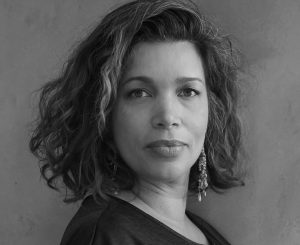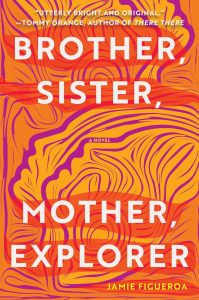The PEN Ten: An Interview with Jamie Figueroa
The PEN Ten is PEN America’s weekly interview series. This week, Jared Jackson speaks with Jamie Figueroa, author of Brother, Sister, Mother, Explorer (Catapult, 2021).

Photo by Zoë Zimmerman
1. How does your writing navigate truth? What is the relationship between truth and fiction?
My writing navigates truth by being aware of its own limitations in perspective. While I strive to include as many perspectives as possible in my work—inclusion is a value, and the truth of my reality and community—I’m conscious of its limitation, of my limitations. My intention is to connect and stay in relationship with what I’m writing—that includes the characters who may be blind to themselves and to each other, and the expression of place: life in its various forms, sky, water, plant, animal. To be in relationship means making space for various experiences: how the fox sees the sky, how the sky sees the protagonist, how the protagonist feels the river, how the river feels the rocks, how the rocks sense the secondary characters, how the secondary characters sense the reader.
With fiction, I can express and include many of these truths while bypassing, at least some of the time, rational, analytical mental confines—the prison of binary thinking and the caged imagination, which are signatures of historical and ongoing colonization. With story, as with poetry, I’m able to use metaphor, language that penetrates and haunts, that speaks to the psyche. And the truth of fiction and of story is that it has the ability to transcend its details and transform us.
“With story, as with poetry, I’m able to use metaphor, language that penetrates and haunts, that speaks to the psyche. And the truth of fiction and of story is that it has the ability to transcend its details and transform us.”
2. What was one of the most surprising things you learned in writing your book?
That it came to an end! I realize that may sound obvious and strange, but surrendering to the process again and again became such a practice for years, and the edits seemed endless—akin to polishing a stone. I was continuously asking, “Is this sentence the best it possibly can be? Is this word as close to perfect as I can manage it? Do these characters have any more they need me to express on their behalf?”
The other thing that surprises me, related to that, is how when I read it now, there are places in the text where I tear up as if I hadn’t written and revised it numerous times. Another strange, unexpected occurrence for sure. It’s a kind of grief, in a sense, and fondness for the active presence of that particular work—how it became a kind of companion and ballast.
3. What do you consider to be the biggest threat to free expression today? Have there been times when your right to free expression has been challenged?
As a BIPOC writer, I believe the biggest threat to free expression today is unchecked, embedded racism and misogyny. Lack of personal awareness and accountability combined with systematic, institutional oppression makes for a power dynamic that dehumanizes those whose stories and perspectives we need the most in order to balance power, to restore justice and dignity, and to heal.
“Lack of personal awareness and accountability combined with systematic, institutional oppression makes for a power dynamic that dehumanizes those whose stories and perspectives we need the most in order to balance power, to restore justice and dignity, and to heal.”
4. How does your identity shape your writing? Is there such a thing as “the writer’s identity?”
I think about the Anais Nin quote, “We don’t see things as they are. We see things as we are.” Which is to say, our reality is very much shaped by the details of who we are. Even our imaginations can be restricted by our own personal experience of reality. To that extent, my identity is the entry point from which I access a larger, universal experience. I am highly aware of that. When rendering characters, I feel responsible to express, to the best of my ability, the complexity of a human life.
I’m aware of appropriation versus appreciation. I’m aware of how easy it is to turn a character into a caricature. I’m aware of the dangerous territory of entitlement and hierarchical thinking because I can read and write, am educated, and have influence. I’m aware of the writers whose books are shelved with “fiction” and “literature” versus the writers whose books are shelved in a corner, or someplace else, set apart based on their identities. Privilege, inherited privilege, and the lack thereof is intertwined with how we see ourselves and each other. This influences the kinds of stories we are capable of, gravitate toward, and pass along.
I think while each writer has their own way to be and to work, there can be a shared “writer’s identity.” There can be a common language we engage when referencing the process that others who aren’t devoted to writing are unable to understand. There can also be a similarity of being, beneath the personal details, of sensitivity and perception, of tracking details to be translated onto the page and of hours spent communing with unseen forces.
“Our reality is very much shaped by the details of who we are. Even our imaginations can be restricted by our own personal experience of reality. To that extent, my identity is the entry point from which I access a larger, universal experience. ”
5. In literature, we speak about the white gaze, the assumption that the default reader is someone who identifies as white, and how that affects writers of color. Your novel examines the white gaze quite literally, as white tourists gawk at and romanticize Rufina and Rafa’s desert town performances. As a writer, what made you want to examine the white gaze in your novel? What’s the impact of the white gaze on your characters?
I believe one of the responsibilities of my work is to challenge the limitations of dominant culture, subvert typical, assumed narratives, and I wanted to implicate the reader. The narrator(s) insisted on not allowing anyone to be a spectator, passing judgment without being involved. They immediately revoke any assumed privilege and put the reader in relationship—being in relationship also means an awareness of connection and of responsibility. Jamaica Kincaid’s A Small Place was an inspiration to me as was ZZ Packer’s story, “Brownies.”
6. What is one book or piece of writing you love that readers might not know about?
In Aurora Levins Morales’ essay “Revision,” she explores and explains some of the history of the island of Boriken and of being Boricua. It is rich in imagery and thorough in its poetic listing/accounting. She uses the refrain, “Let’s get one thing straight.” It is proclamation and affirmation, and it nourishes. For any BIPOC, it is also an invitation to acknowledge how history is active in our current daily life, how to correct what historical accounts have neglected, and how to ground oneself through the strength of ancestors in spite of the difficulties of generational trauma.
7. Why do you think people need stories?
Why do people need food and water? That’s how strongly I feel about the function of stories. We need stories to survive. . . to remember, to imagine, to inspire. . . to survive.
“Why do people need food and water? That’s how strongly I feel about the function of stories. We need stories to survive. . . to remember, to imagine, to inspire. . . to survive.”
8. What advice do you have for young writers?
READ! Cultivate a love for literature and a passion for reading. Take regular vacations from the screen and technology to go outside. Sensitize yourself to all of your senses. Slow down, pay attention, and delight in all that the world is waiting for you to receive. Practice specificity. Take creative risks.
 9. Stories are a form of sensemaking, binding experiences together and maintaining them in relationship to each other. Your debut novel, Brother, Sister, Mother, Explorer, follows two half-siblings mourning the death of their mother. How did you approach communicating the pains of trauma and grief—connecting these emotions—when shaping the novel?
9. Stories are a form of sensemaking, binding experiences together and maintaining them in relationship to each other. Your debut novel, Brother, Sister, Mother, Explorer, follows two half-siblings mourning the death of their mother. How did you approach communicating the pains of trauma and grief—connecting these emotions—when shaping the novel?
I had to relate to them through my own pain, trauma, and grief. In that way, this novel is part emotional autobiography. I had the support and encouragement of my agent, PJ Mark, to face the most intense moments of pain, to gather strength and go slowly, bearing witness and being tender with my characters and with myself.
10. Narrative design—the controls the writer places on the story, the expectations the writer generates in the reader, and the patterns the writer utilizes as the story progresses—is one of the defining ways that a writer makes the story their own. Brother, Sister, Mother, Explorer is artfully constructed. Did the form arise from the need for it? Did content dictate structure? How did you make these decisions?
The content absolutely dictated structure. In early drafts, the manuscript had an opaque, dream-like quality to it where readers felt strongly but were unsure of exactly what was going on, when, and what was at stake. I had to simplify—the weekend, and the bet—in order to make some things very straightforward and provide tension. In doing this, I tried to build trust with the reader so that we could traverse the troubling, complicated and transformative, together.
Jamie Figueroa received her MFA in creative writing from the Institute of American Indian Arts. Her writing has appeared in Epoch, McSweeney’s, and American Short Fiction. She is the recipient of the Truman Capote Scholarship and is a Bread Loaf scholar. Boricua by way of Ohio, Figueroa lives in New Mexico.






